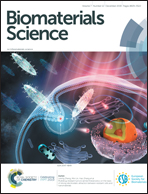Enhanced performance of chitosan/keratin membranes with potential application in peripheral nerve repair
Abstract
Although surgical management of peripheral nerve injuries (PNIs) has improved over time, autografts are still the current “gold standard” treatment for PNIs, which presents numerous limitations. In an attempt to improve natural biomaterial-based nerve guidance conduits (NGCs), chitosan (CHT), a derivative of the naturally occurring biopolymer chitin, has been explored for peripheral nerve regeneration (PNR). In addition to CHT, keratin has gained enormous attention as a biomaterial and tissue engineering scaffolding. In this study, biomimetic CHT/keratin membranes were produced using a solvent casting technique. These membranes were broadly characterized in terms of their surface topography and physicochemical properties, with techniques such as Fourier Transform Infrared Spectroscopy (FTIR), Differential Scanning Calorimetry (DSC), contact angle, weight loss and water uptake measurements, Scanning Electron Microscopy (SEM) and Atomic Force Microscopy (AFM). Biological in vitro assays were also performed, where a preliminary cytotoxicity screening with the L929 fibroblast cell line revealed that the membranes and respective materials are suitable for cell culture. In addition, Schwann cells, fibroblasts and endothelial cells were directly seeded in the membranes. Quantitative and qualitative assays revealed that the addition of keratin enhanced cell viablity and adhesion. Based on the encouraging in vitro results, the in vivo angiogenic/antiangiogenic potential of CHT and CHT/keratin membranes was assessed, using an optimized chick embryo chorioallantoic membrane assay, where higher angiogenic responses were seen in keratin-enriched materials. Overall, the obtained results indicate the higher potential of CHT/keratin membranes for guided tissue regeneration applications in the field of PNR.



 Please wait while we load your content...
Please wait while we load your content...